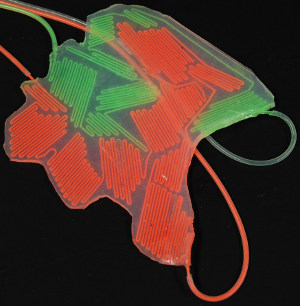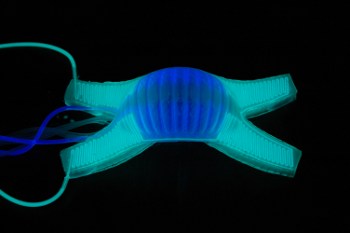 |
| September 04, 2012 | Volume 08 Issue 33 |
Designfax weekly eMagazine
Archives
Partners
Manufacturing Center
Product Spotlight
Modern Applications News
Metalworking Ideas For
Today's Job Shops
Tooling and Production
Strategies for large
metalworking plants
DARPA soft robots hide in plain sight

In DARPA's soft robot, the microfluidic networks used for camouflage or display are contained in thin silicone sheets referred to as color layers. Various heated or cooled dye, chemiluminescent, and fluorescent solutions and water can be pumped through the color layers to adjust temperature and appearance.
This robot is made of silicone. It can walk, change color, and light up in the dark. It can even change temperature. And it can do all of this for less than $100. In the future, robots like this might be made for just a few dollars.
In a development reported in the August 17 issue of Science, researchers led by Drs. George Whitesides and Stephen Morin at Harvard University's Department of Chemistry and Chemical Biology and the Wyss Institute for Biologically Inspired Engineering demonstrated that microfluidic channels in soft robots enable functions including actuation, camouflage, display, fluid transport, and temperature regulation. The work is being performed under DARPA's Maximum Mobility and Manipulation (M3) program.
Why does this matter to the Department of Defense? DARPA foresees robots of many shapes and sizes contributing to a wide range of future defense missions, but robotics is still a young field that has focused much of its attention so far on complex hardware. Consequently, the costs associated with robotics are typically very high.
What DARPA has achieved with silicone-based soft robots is development of a very low-cost manufacturing method that uses molds. By introducing narrow channels into the molds through which air and various types of fluids can be pumped, a robot can be made to change its color, contrast, apparent shape, and temperature to blend with its environment; glow through chemiluminescence; and, most importantly, achieve actuation, or movement, through pneumatic pressurization and inflation of the channels. The combination of low cost and increased capabilities means DARPA has removed one of the major obstacles to greater DoD adoption of robot technology.

In nature, some organisms use bioluminescence to communicate. DARPA's soft robot achieves the same glowing effect by pumping chemiluminescent solutions through channels in the robot's color layer.
Gill Pratt, the DARPA program manager for M3, put the achievement in context: "DARPA is developing a suite of robots that draw inspiration from the ingenuity and efficiency of nature. For defense applications, ingenuity and efficiency are not enough -- robotic systems must also be cost effective. This novel robot is a significant advance towards achieving all three goals."
In the video below, a soft robot walks onto a bed of rocks and is filled with fluid to match the color of the rocks and break up the robot's shape. The robot moves at a speed of approximately 40 meters per hour; absent the colored fluid, it can move at approximately 67 meters per hour. Future research will focus on smoothing the movements; however, speed is less important than the robot's flexibility. Soft robots are useful because they are resilient and can maneuver through very constrained spaces.
For this demonstration, the researchers used tethers to attach the control system and pump pressurized gases and liquids into the robot. Tethered operation reduces the size and weight of such robots by leaving power sources and pumps off-board, but future prototypes could incorporate that equipment in a self-contained system. At a pumping rate of 2.25 milliliters per minute, color change in the robot required 30 seconds. Once filled, the color layers require no power to sustain the color.
Aside from their potential tactical value, soft robots with microfluidic channels could also have medical applications. The devices could simulate fluid vessels and muscle motion for realistic modeling or training, and may be used in prosthetic technology.
Source: DARPA
Published September 2012
Rate this article
View our terms of use and privacy policy
